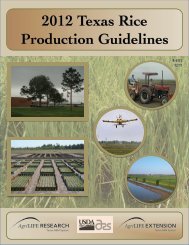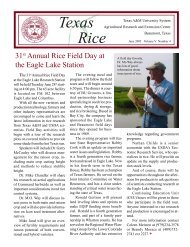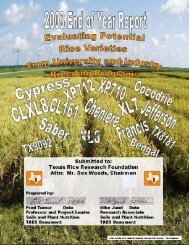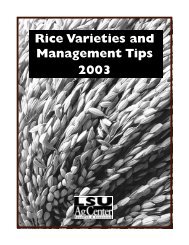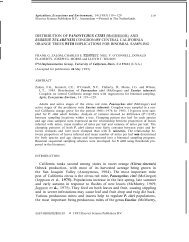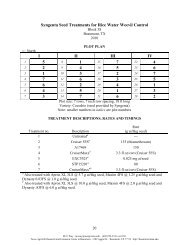2007 - Texas A&M AgriLIFE Research Center at Beaumont - Texas ...
2007 - Texas A&M AgriLIFE Research Center at Beaumont - Texas ...
2007 - Texas A&M AgriLIFE Research Center at Beaumont - Texas ...
You also want an ePaper? Increase the reach of your titles
YUMPU automatically turns print PDFs into web optimized ePapers that Google loves.
The l<strong>at</strong>e-boot applic<strong>at</strong>ion is most important if there are<br />
leaf lesions caused by blast. The heading applic<strong>at</strong>ion is more<br />
important to protect panicles from spore showers. Blast is<br />
favored by excessive nitrogen fertility, thick stands, lighter<br />
soils and inadequ<strong>at</strong>e flooding.<br />
Kernel smut<br />
Kernel smut is a serious disease caused by the fungus<br />
Tilletia barclayanna (Neovossia horrida). The disease<br />
causes the endosperm of the rice grain to be replaced completely<br />
or partially by a black mass of smut spores. Usually<br />
only one to five grains per panicle are infected.<br />
Although yield losses are insignificant, monetary losses<br />
can be very high if the rice cannot be sold or the price is<br />
reduced <strong>at</strong> the mill. Infested lots of grain often have a dull,<br />
grayish cast caused by the smut spores. Rice lots exceeding<br />
3 percent kernel smut infection presently will not qualify<br />
for government loan.<br />
The disease is not systemic. The smut spores fall to the<br />
soil surface, where they remain dormant until the following<br />
rice crop, or they can be introduced into a field on<br />
the surface of infested rice seed. The smut spores flo<strong>at</strong> to<br />
the surface of the irrig<strong>at</strong>ion w<strong>at</strong>er where they germin<strong>at</strong>e<br />
and produce air-borne spores which infect individual rice<br />
florets. Disease development is favored by frequent light<br />
showers and high rel<strong>at</strong>ive humidity.<br />
Kernel smut is difficult to control. Field tests indic<strong>at</strong>e<br />
th<strong>at</strong> a l<strong>at</strong>e-boot applic<strong>at</strong>ion of Tilt ® or Propimax ® <strong>at</strong> 4 to<br />
6 fluid ounces per acre reduces the number of smutted<br />
kernels. The semidwarf varieties Lemont and Gulfmont are<br />
less susceptible to the disease than Cocodrie or Cypress.<br />
Heavy nitrogen fertiliz<strong>at</strong>ion favors the disease. A 3-year<br />
crop rot<strong>at</strong>ion should help reduce the number of smut spores<br />
present. Do not plant seed contamin<strong>at</strong>ed with smut spores.<br />
She<strong>at</strong>h blight<br />
She<strong>at</strong>h blight, caused by the fungus Rhizoctonia solani,<br />
has rapidly become the most important rice disease in<br />
<strong>Texas</strong> and probably the second most important rice disease<br />
worldwide.<br />
A change in cultural practices during the 1980s is the<br />
reason for this. The increased use of she<strong>at</strong>h-blight-susceptible<br />
semidwarf varieties, along with the recommended<br />
high nitrogen fertiliz<strong>at</strong>ion required to obtain their maximum<br />
yield potential, has resulted in much gre<strong>at</strong>er losses from<br />
she<strong>at</strong>h blight. Also, the trend toward shorter crop<br />
rot<strong>at</strong>ions has made the disease more troublesome by<br />
allowing the fungus to increase in quantity within fields.<br />
As a result, rice producers have increased their reliance on<br />
fungicides to manage she<strong>at</strong>h blight.<br />
Cultural control<br />
To most effectively and economically reduce losses<br />
from she<strong>at</strong>h blight, use an integr<strong>at</strong>ed package of management<br />
practices. Some practices may be economical only<br />
where she<strong>at</strong>h blight is a persistent, significant problem.<br />
Others are recommended in all situ<strong>at</strong>ions as sound production<br />
practices th<strong>at</strong> will help prevent the buildup of a she<strong>at</strong>h<br />
blight problem or limit its effects where the problem exists.<br />
Some recommended cultural practices include:<br />
• Avoiding excessive seeding r<strong>at</strong>es, which result in a<br />
very dense canopy th<strong>at</strong> cre<strong>at</strong>es a microclim<strong>at</strong>e<br />
favorable to disease development.<br />
• Avoiding excessive r<strong>at</strong>es of nitrogen fertiliz<strong>at</strong>ion,<br />
which increase the severity of the disease.<br />
• Where possible, increase the interval between rice<br />
crops to <strong>at</strong> least 1 year of rice in every 3 years.<br />
<strong>Research</strong> has shown th<strong>at</strong> rot<strong>at</strong>ions of pasture-pasturerice,<br />
soybean-soybean-rice and rice-soybean-rice had<br />
average incidence of she<strong>at</strong>h blight of 0.4, 2.7 and 5.4<br />
percent, respectively, <strong>at</strong> panicle differenti<strong>at</strong>ion. In addition,<br />
more she<strong>at</strong>h blight inoculum for future rice crops<br />
tends to be produced in drilled soybeans than<br />
in row-planted soybeans.<br />
• Controlling grass weeds th<strong>at</strong> can serve as hosts of the<br />
she<strong>at</strong>h blight fungus. Barnyardgrass, crabgrass and<br />
broadleaf signalgrass are known hosts of the p<strong>at</strong>hogen.<br />
Variety selection<br />
Long-grain rice varieties differ in their susceptibility to<br />
she<strong>at</strong>h blight. Among those considered very susceptible are<br />
Cocodrie, Gulfmont and Cypress.<br />
Less susceptible (moder<strong>at</strong>ely susceptible) are Jefferson,<br />
Saber and most of the medium grain varieties. Taller varieties<br />
tend to sustain less loss than semidwarf varieties.<br />
Chemical control<br />
In many situ<strong>at</strong>ions, foliar fungicides may be economically<br />
justified for reducing losses from she<strong>at</strong>h blight if:<br />
• The disease pressure is sufficiently high;<br />
• Susceptible varieties of rice are grown;<br />
• The crop has a high yield potential in the absence of<br />
she<strong>at</strong>h blight; and<br />
• Environmental conditions are favorable for the disease<br />
to spread to the upper leaves of the rice plant.<br />
It is difficult to estim<strong>at</strong>e the potential severity of she<strong>at</strong>h<br />
blight in a field in order to determine the economic feasibility<br />
of applying a fungicide. However, with the high costs of<br />
fungicide spray programs and the need to reduce production<br />
costs, estim<strong>at</strong>es should be made.<br />
To estim<strong>at</strong>e the severity of she<strong>at</strong>h blight infest<strong>at</strong>ion,<br />
monitor the field <strong>at</strong> or shortly after panicle differenti<strong>at</strong>ion<br />
(PD) growth stage (See Fig. 3). It may not be necessary<br />
to precisely monitor a field with a recent history of severe<br />
she<strong>at</strong>h blight th<strong>at</strong> is on a short crop rot<strong>at</strong>ion (more than one<br />
rice crop in a 3-year interval).<br />
Figure 3. Panicle differenti<strong>at</strong>ion (PD).<br />
–––––––––––––––––––––––––––––––––––––––––––––––––––––––––––––––––––––––––––––––––––– 29



